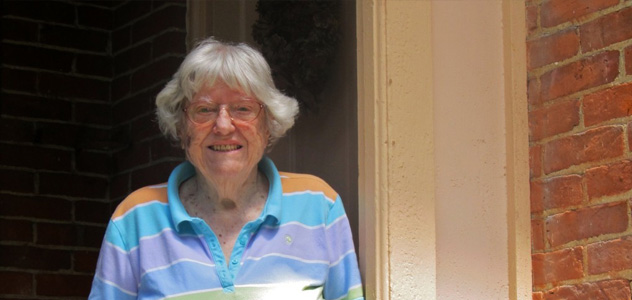
I’m sitting in Carole Boulette’s kitchen. Dishes line the counter next to the sink. There’s a small bag of cat food in one corner, and a large yellow sign on the wall that reads, “Beware of cat.” Carole sits in a chair next to me. I’ve told her beforehand that we were going to talk about the Huss building. Smiling, she turns up her hearing aid.
Growing up ten blocks away from Huss Elementary School, a young Carole lived on the edge of Three Rivers. She began attending Huss in 1922 as a kindergarten student, and continued there through the sixth grade, after which she began high school. “We used to walk to school, winter or summer. It didn’t matter about the weather. We went,” says Carole, now 96 years old. “We cut through people’s backyards to get to school.”
Carole tells me as much as she can remember. Second grade was especially clear for her. “Mrs. Freeland,” she says, “taught us a lot about pets and birds and butterflies.” The students had weekly music appreciation days as well as routine art classes. The playground was well-furnished with bars and slides, and Carole remembers how the sixth graders seemed like giants to the younger children.
“I liked school,” Carole says, “There were caring teachers. Some of the things in our textbooks then are things that the older kids have now.” When I ask her about the subjects she learned at school, Carole quips, “Math was my worst subject, but I jumped a grade and missed some basic math. We didn’t have any adding machines and calculators then.” However, Carole was an avid reader. She says she had a thorough education at Huss, learning extensively about grammar and literature, and reciting poetry as she walked home from school.
The neighborhood was also a well-connected community back then. “We grew up together,” Carole says about her twenty-or-so classmates. “You knew them better than when you get over to junior high and high school, and you had special buddies that you played with out in the school yard.” As for the demographics of her school, “it was a pretty broad spectrum of kids,” Carole recalls. “I mean some poor, and some with more money than others, but we all just blended together.” She shares a rhyme that the kids used to recite on the playground:
First ward sissy cats,
Second ward toughs,
Third ward cherry pits, and
Fourth ward bluffs.
“I don’t think we were any tougher than other people,” Carole laughs, thinking back to the kinds of families living in the neighborhood. I ask her about how things have changed since her time at Huss. She looks out her window. The streets and sidewalks are empty. “People in the old days, before the television, would sit out on their porches and they were friendlier. You knew your neighbors. Now, I have neighbors that I never see, except when they go out to their car. I think that’s sad.”
When I tell her about *culture is not optional and our mission to use the Huss building as a community center, Carole smiles. “I’m glad,” she says. “Maybe your group will bring back some of that friendliness.” Ms. Boulette is happy to hear that the school still stands strong, and that it is being put to use. “Because, you know, it was a good solid building. Better made than most, like this house,” she points to her brick walls outside. “Modern houses will be long gone, but Huss will last a long time, too.”
Carole’s recollection of Huss as an elementary school helps us appreciate the kind of legacy that it left for its students. Today, many people we encounter in Three Rivers tell us that they used to attend Huss, either as an elementary student or an older student. We’re happy to hear their stories and remember what Huss used to be. Their voices, each one a strong and precious brick, pave the path ahead of us as we move into the future of The Huss Project.



